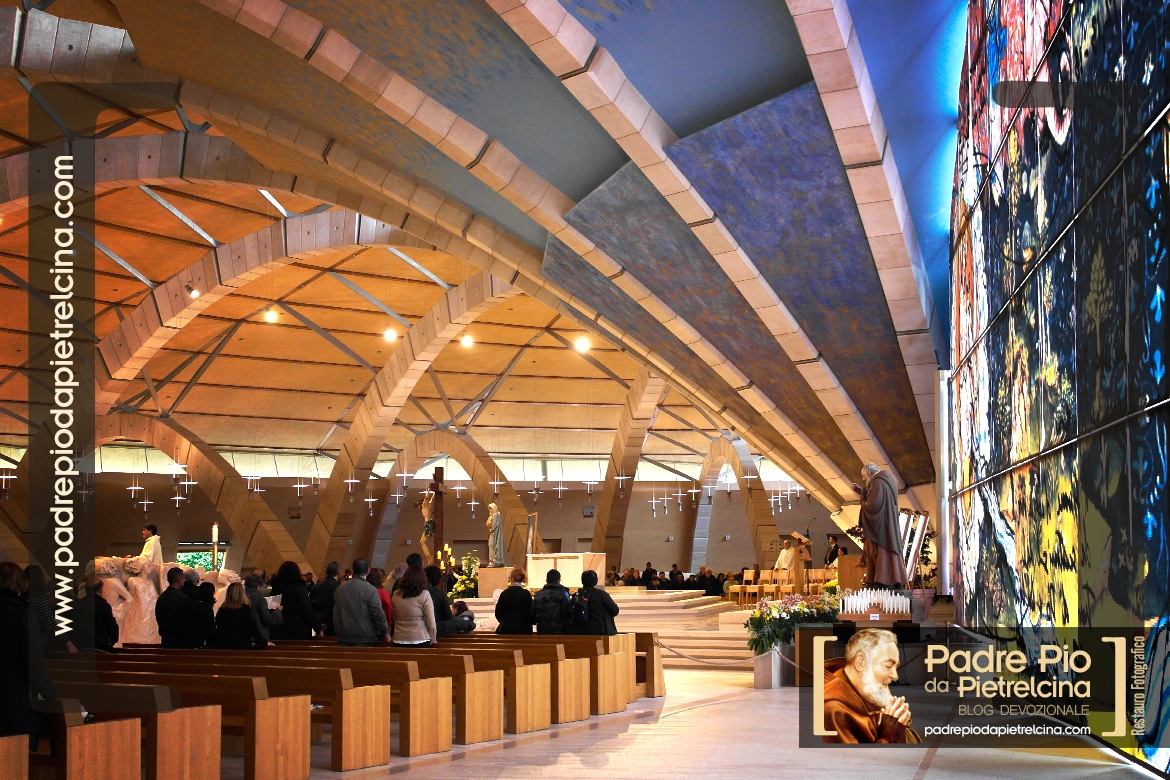The Sanctuary of Saint Pio of Pietrelcina is a sacred space where faith, art, and architecture blend seamlessly, providing the faithful with a unique and unforgettable spiritual experience. This holy site invites visitors on a contemplative journey that honors and celebrates the life and legacy of Padre Pio.
The Sanctuary of Saint Pio of Pietrelcina
Located in San Giovanni Rotondo, in the province of Foggia, Italy, the Sanctuary of Saint Pio of Pietrelcina is a profound spiritual haven, welcoming pilgrims from around the world. This sacred site houses the precious relics of Saint Pio, offering a space for prayer, reflection, and connection. This monumental architectural masterpiece, designed by renowned Italian architect Renzo Piano, covers an impressive 6,000 square meters. It has the capacity to hold up to 6,000 seated worshippers, with space for an additional 10,000 standing attendees, making it one of the largest and most awe-inspiring religious structures in the world. The sanctuary’s modern design is constructed using materials sourced from regions closely tied to Padre Pio, including the stunning Apricena stone, celebrated for its timeless beauty and durability. The Sanctuary is celebrated for its profound architectural symbolism, with every detail crafted to reflect the life and teachings of Saint Pio. At its center stands a towering pillar, the structural and symbolic heart of the design. From this pillar, elegant arches radiate outward, creating a striking and unique silhouette. At the base of the central pillar lies a sacred reliquary containing the body of Saint Pio, a focal point for pilgrims seeking comfort, healing, and spiritual renewal. A remarkable story underscores the construction of the central concrete pillar. Its completion required at least four consecutive days of ideal weather—a seemingly impossible feat during the harsh winter months. On February 11, 1998, despite freezing temperatures, work began against all odds. Miraculously, as the concrete was poured, the cold gave way to an unexpected warmth, creating perfect conditions for the task. Once the work was complete, the chill returned just as suddenly. Witnesses were awestruck, interpreting this event as a manifestation of divine grace and protection. The Sanctuary of Saint Pio is not just a place of worship but a testament to the enduring legacy of Padre Pio, where faith, art, and architectural brilliance converge to inspire all who visit.

The Forecourt of the Sanctuary: A Symbolic Welcome
The forecourt of the Sanctuary of Saint Pio extends a profound and symbolic embrace to all who visit, drawing deeply from the roots of Christian faith. Twenty-four majestic olive trees are thoughtfully arranged to represent the twelve prophets of the Old Testament and the twelve apostles of Christ, creating a seamless link between the sacred past and the living present. Nearby, a fountain inspired by the Jordan River—a holy site of Jesus’ baptism—captures the eye and stirs the soul. Its design creates a unique and resonant sound, echoing the gentle flow of sacred waters and enveloping visitors in an atmosphere of peace and reflection.
The Bell Tower: Tradition and Spirituality in Harmony
The Sanctuary’s bell tower rises with commanding grace, an elegant testament to faith and tradition. It houses eight resounding bells, masterfully forged by the historic Pontifical Marinelli Foundry of Agnone, each named after a saint of the Franciscan Order. These bells honor the deep spiritual connection to the Franciscan tradition. Adding to the tower’s solemn beauty, eight stone eagles, intricately sculpted by artist Mario Rossello, stand guard, their vigilant presence embodying strength and reverence as they watch over the sacred space.
Renzo Piano’s Cross: The Spiritual Heart of the Sanctuary
Soaring above the entire Sanctuary, the cross designed by Renzo Piano commands the skyline, a powerful and awe-inspiring symbol of faith. Elegant in its simplicity yet monumental in scale, this cross serves as the spiritual heart of the Sanctuary. It stands as a beacon of hope and devotion, visible from miles away, inspiring and guiding pilgrims on their sacred journeys.
The Upper Church of the Sanctuary: A Harmony of Architecture and Spirituality
Situated at the highest point of the Sanctuary of Padre Pio, the Upper Church is a stunning embodiment of architectural harmony and artistic symbolism. This sacred space is thoughtfully divided into three main areas: the liturgical hall, the Eucharistic chapel, and the sacristy. Each area is meticulously crafted to cultivate an atmosphere of prayer and meditation, inviting moments of deep reflection and spiritual connection. The church’s design is anchored by 22 sweeping arches that extend gracefully from a central pillar, creating an aura of majesty and reverence.
The Altar and the Ambo: Symbols of Faith and Hope
At the center of the radiating arches stands the altar, a magnificent masterpiece by renowned artist Arnaldo Pomodoro. Its commanding presence and profound symbolism establish it as the spiritual and liturgical heart of the Sanctuary. Adjacent to the altar is the ambo, a striking piece carved from a single block of polished stone by Giuliano Vangi of Pietrasanta. This sculpture narrates the journey of the divine word, beginning with Nicodemus and culminating with Mary Magdalene, the first to proclaim the Resurrection. Together, the altar and ambo symbolize faith and hope, inviting visitors to meditate on the mystery of redemption.
The Grand Organ: A Symphony of Art and Sound
On the left side of the church stands the grand organ, a masterpiece of artistry and devotion. Featuring 5,800 meticulously hand-crafted pipes made by the skilled artisans of Pinchi in Foligno, the organ enriches liturgical celebrations with its majestic, transcendent sound. Beyond being an extraordinary instrument, it serves as a symbol of spiritual elevation, intertwining faith and music in a single, uplifting melody.
The Stained Glass Windows: Illuminating the Light of Faith
The stained glass windows of the Sanctuary of Saint Pio of Pietrelcina in San Giovanni Rotondo are stunning creations by renowned artists, including Marko Ivan Rupnik and the master glassmakers of Murano. These vibrant works depict scenes from the life of Padre Pio as well as key biblical narratives, celebrating the saint’s enduring legacy within Christian faith. Liturgical symbols such as the Paschal Lamb and the bread and wine highlight themes of redemption and hope. Positioned along the church walls, the windows harness natural light to create a captivating interplay of color and meaning, inspiring reflection and prayer within their radiant glow.
The Chapel of the Blessed Sacrament: A Place of Profound Spiritual Intensity
Located adjacent to the liturgical hall, the Chapel of the Blessed Sacrament exudes a powerful sense of spiritual depth and artistic splendor within the Sanctuary of Padre Pio. This sacred space offers visitors a tranquil refuge for prayer and meditation, making it a central destination for pilgrims seeking a deeper connection to their faith.
The Tabernacle by Floriano Bodini: Nature’s Power and Unshakable Faith
At the heart of the chapel stands the tabernacle, a commanding masterpiece by artist Floriano Bodini. Sculpted from a 40-quintal block of volcanic rock sourced from Mount Etna, the tabernacle’s raw, rugged presence symbolizes the immense power of nature and the enduring strength of faith. Its grandeur conveys a profound message of spiritual resilience and stability, anchoring the chapel in an atmosphere of reverence and awe.
The Frescoes of Sister Elisa Aletti: Resurrection and the Franciscan Tradition
The chapel’s walls are adorned with vivid frescoes by Sister Elisa Aletti, each a celebration of the Resurrection. These intricate works bring the Paschal mystery to life, interweaving elements of Padre Pio’s story with verses from the Canticle of the Creatures, a tribute to the rich Franciscan tradition. The frescoes’ vibrant colors and intricate details invite deep contemplation, creating a seamless fusion of art and spirituality that resonates with visitors and enhances the chapel’s sacred atmosphere.
A Journey of Faith and Reflection
The Chapel of the Blessed Sacrament invites visitors on a profound spiritual journey, where every detail—from the monumental tabernacle to the evocative frescoes—serves to deepen faith and reflection. This sacred space, a harmonious blend of artistry and devotion, offers a rare opportunity for contemplation and communion with the divine, leaving an indelible impression on all who enter.
The Lower Church: A Sanctuary for Reflection and Meditation
The lower church of the Sanctuary of Padre Pio is a serene refuge, designed to envelop pilgrims in an atmosphere of solemnity and radiant light. The thoughtful interplay of stone, glass, and gold creates a sacred ambiance, encouraging the faithful to reflect on God’s glory and seek a deeper spiritual connection. Every architectural element is meticulously crafted to inspire meditation and foster an intimate experience of the divine.
The Mosaics of Marko Ivan Rupnik
The walls of the lower church are adorned with breathtaking mosaics, the work of Marko Ivan Rupnik and the Aletti Center Atelier. These intricate masterpieces illustrate biblical stories and pivotal moments in the life of Padre Pio, guiding pilgrims through a spiritual narrative of redemption and sanctity. The vivid colors and carefully arranged imagery transform the church into a living tapestry, lifting hearts and minds toward a profound encounter with the divine.
The Symbolic Ramp
The journey to the lower church begins with a symbolic ramp, a thoughtfully designed path that prepares pilgrims for their encounter with the heart of the Sanctuary. Adorned with mosaics depicting biblical stories and Christian symbols, the ramp serves as both a visual and meditative guide. This gentle descent represents an inner spiritual journey, inviting visitors to leave behind the distractions of the world and step into a deeper realm of faith and reflection.
The Central Pillar: A Symbol of Christ
The central pillar stands as both the structural and symbolic heart of the church, embodying Christ as the foundation of the Church and the guiding presence for all believers. This architectural centerpiece not only supports the physical structure of the Sanctuary but also symbolizes Christ’s role as the cornerstone of faith. From this central axis, all spaces in both the upper and lower churches radiate outward, emphasizing the spiritual unity and interconnectedness of the entire site.
The Crypt of Saint Pio: The Beating Heart of the Lower Church
Immersive and intimate, the lower church draws pilgrims into a sacred space designed for prayer and meditation. At its center lies the crypt, the beating heart of the church, where the glass-encased remains of Saint Pio rest. This sacred focal point inspires profound veneration, inviting the faithful into silent communion with the saint. The arrangement of the space, centered around the pillar and enriched by mosaics, amplifies the spiritual experience, intertwining narratives of faith, sanctity, and devotion.
The Golden Ceiling: A Symbol of Divine Light
The gilded ceiling of the lower church commands attention with its dazzling brilliance. Representing divine light and celestial glory, this golden expanse was offered by pilgrims as a votive gift. Its reflective surface captures and radiates light, bathing the sanctuary in a glow that evokes the splendor of heaven. This shimmering masterpiece invites contemplation and envelops the entire space in an aura of sacred majesty, elevating the spiritual atmosphere to one of transcendent beauty.
An Experience of Faith and Spirituality
The Sanctuary of Saint Pio serves as a beacon of faith, offering profound moments of reflection and devotion to all who enter. Comprising a lower church, an upper church, and thoughtfully designed spaces for prayer and pilgrim hospitality, the Sanctuary masterfully weaves together art, architecture, and spirituality into a cohesive and uplifting experience. Every corner of this sacred space is imbued with deep symbolism, making it a truly unique destination for Christian devotion and pilgrimage. It invites visitors to embark on a transformative journey of faith, contemplation, and spiritual renewal.






